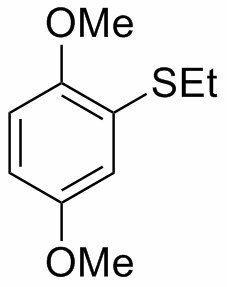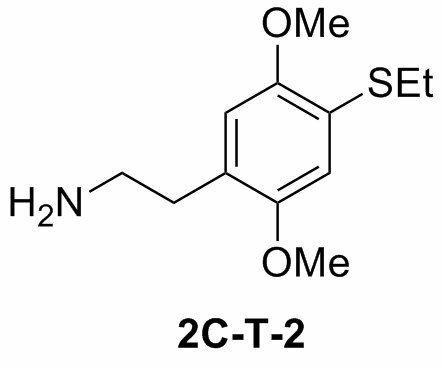
Last Monday I set my MSci student the task of preparing the above compound and sent him off to do some literature searching. He quickly found a mention of it in a J. Med. Chem. paper, although the authors didn't give any detail themselves on its preparation, instead claiming to have used the method of Shulgin and Shulgin, described in reference 17:

That's right: a reference to PIHKHAL in the primary chemical literature! When I got over my initial surprise I did track down a copy (the university library didn't have it) to look up the procedure. Indeed, a very detailed and reasonable sounding synthesis of the compound is described under the chapter on the synthesis of 2C-T-2 (along with an evocative description of just how high you can get on it).[1]

There's lots of detail and the whole thing is done on sufficient scale to produce 10 grams of the desired compound. Perhaps not too surprisingly, the route starts with chlorosulfonation of 1,4-dimethoxybenzene, followed up with reduction (Zn in HCl) to give the thiophenol which is then ethylated. Easy. We're going to try it this week, and I will enjoy seeing PIHKAL referenced in a lab notebook. It's funny, I've been aware of this book for probably ten years or more - heck, I even gave a talk last year entitled 'Quinones I Have Known And Loved' - but I never thought I'd be reading it at work. Steven Weinreb once said of Russell Marker: "There are more stories told about [him] than any other chemist. Although perhaps many of these stories are apocryphal, they are so fascinating that more of us cannot bear to stop repeating them... they are the campfire stories that bind our profession together",[2] but I think that the same could also easily be said of Shulgin. I mean, along with Humphry Osmond the man actually coined the term 'psychedelic'.[3] I learned today that there's even a Shulgin Index, written in the style of the more common Merck index, describing the physical and pharmacological properties of some of the psychedelics he and others prepared over the years. I hope to one day have the chance to read a copy.
Etc
1. More in this vein can be enjoyed in the digitised versions of Shulgin's lab notebooks. Although his handwriting, combined with the quality lost from storage and scanning, can make them quite hard to read in places they seem to be quite interesting and frequently amusing and insightful. Although the first entry in the first book describes his experiences of taking 400 mgs of mescaline sulfate and the results (which, including hallucinations experienced with eyes open and shut were 'very pleasant'), there's also some real explorative medicinal chemistry documented there. They're actually much better kept than the lab books of many PhD chemists I have worked with, and it's easy to forget that this work was largely conducted in a shed in California. If it wasn't, you know, for all the drug taking.
2. Chem. Eng. News, 1999, 77, 78; If you don't have access to that the article was also reprinted verbatim in The Journal of The Mexican Society the same year and can be enjoyed for free here.
3. It's interesting to note that this term come from the Greek for 'mind manifesting', which I think speaks of the pair's optimism for the curative power of such compounds. Hopefully I'll do another post on chemical etymology one day.
